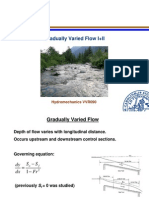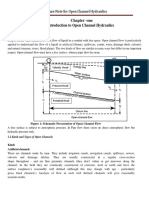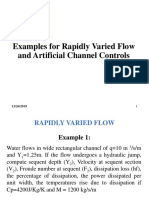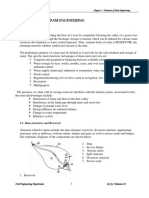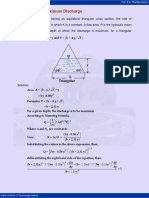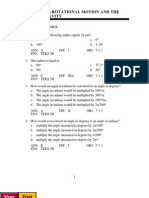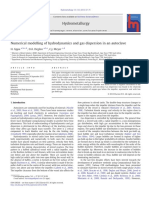Chapter 2 - Gradually Varied Flow (GVF)
Uploaded by
Obsi Naan JedhaniChapter 2 - Gradually Varied Flow (GVF)
Uploaded by
Obsi Naan JedhaniOpen Channel Hydraulics Chapter 2 (April, 2020)
2. Gradually Varied Flow (GVF)
In uniform flows the cross section through which water flows remains constant. Also the
velocity remains the same, in magnitude and direction. In varied flow the cross section
changes in the flow direction, the water depth changes along the length of the channel.
Varied flow may be either steady or unsteady. Since unsteady uniform flow is rare, the
term "unsteady flow” is used for unsteady varied flow exclusively. Varied flow may be
further classified as either rapidly or gradually varied.
The flow is rapidly varied if the depth changes abruptly over a comparatively short
distance; otherwise, it is gradually varied. A rapidly varied flow is also known as local
phenomenon examples are the hydraulic jump and the hydraulic drop.
Gradually varied flow is a steady flow, whose depth varies gradually along the channel.
This means that 3 conditions are met.
The hydraulic flow characteristics remain constant in time;
The streamlines are practically parallel meaning the hydrostatic pressure prevails,
Bed friction is assumed to be equal to the friction in uniform flow (Manning, chezy).
Also, the uniform- flow formula may be used to evaluate the energy slope of GVF at
a given channel section.
Therefore, when the depth of flow in an open channel flow varies with longitudinal
distance, the flow is termed as gradually varied. Such situations are found both upstream
and downstream of control sections. In this chapter the theory and analysis of gradually
varied flow are considered.
2.1 General Equation for Gradually varied flow
The main forces involved in open channel flow are inertia, gravity, hydrostatic force due
to change in depth and friction. The first three forces represent the kinetic and potential
energy, while the forth dissipates useful energy into the useless kinetic energy of
turbulence and eventually into heat due to action of viscosity. The total energy of an
elementary volume of water is given as:
Figure 2.1. Schematic sketch of GVF
V2
E = Z + Y +
2g
Where:
Lecture note 2nd Year HWRE Page 1 of 16
Open Channel Hydraulics Chapter 2 (April, 2020)
Z + Y is the potential energy head above a datum
V2
is the kinetic energy head (v = mean velocity in the section).
2g
Each term of the equation represents energy. The gradually varied flow equation is
derived by assuming that for gradually varied flow the change in energy with distance is
equal to the friction loss. For the general equation other losses than friction, like eddy,
bend and/or bridge losses are not included.
Therefore, at any section, the total energy is
V2
E =Z+Y+
2g
Where y = depth of flow, Z = elevation of the channel bottom above a datum and
assuming = 1 and cos = 1 (slope channel is small sin So). Differentiating this
equation with respect to the longitudinal distance x yields:
V2 v2
d Z Y d
2g
dE 2g dy dz
dx dx dx dx dx
dE
The term is the change of energy with longitudinal distance or the friction slope.
dx
Define,
dE
Sf
dx
It should be noted that the friction loss dE is always a negative quantity in the direction of
flow (unless outside energy is added)
dZ
The term is the change of elevation of the bottom of the channel with respect to
dx
distance or the bottom slope.
Define,
dZ
So
dX
It should be noted that the slope is defined as the sine of the slope angle and that it is
assumed positive if it descends in the direction of flow and negative if it ascends. But the
change in the bottom elevation dZ is a negative quantity where the slope descends. Thus,
dZ
the slope of the channel bottom So = sin = -
dx
v 2
d
For a given flow rate Q, the term 2 g becomes
dx
v 2
d
2 g Q 2 dA dy Q T dy
2
dx qA3 dy dx qA3 dx
Lecture note 2nd Year HWRE Page 2 of 16
Open Channel Hydraulics Chapter 2 (April, 2020)
dy
= Fr 2
dx
v2
d
dE 2g dy dz
Substituting, in yields
dx dx dx dx
dy dy
S f Fr So
2
dx dx
So Sf
dy
dx
1 Fr
2
dy So Sf
1 Fr
2
dx
This equation is called the general equation of gradually varied flow (also known as
dynamic equation of GVF). It describes the variation of the depth of flow in a channel of
arbitrary shape as a function of So, Sf and Fr2. Sf represents the slope of the energy line
dE
. For uniform flow the bed slope (So) and the friction slope (Sf) are parallel. The
dx
friction slope (Sf) for non-uniform, gradually varied flow is not parallel to the bottom
slope, but is evaluated using Manning’s the Chezy’s (Colebrook–white) equation. There
is no general explicit solution (although particular solutions are available for prismatic
channels). Numerical methods are normally used.
Note that
dE
Sf
dx
dZ
So
dx
dEs
So Sf
dx
The latter is derived as:
v2
E = Z+Y+
2g
v 2
d Z Y
dE
2 g S
f
dx dx
v 2
d Y
dZ S
dEs 2 g
But f
dx dx dx
dEs dZ
So Sf So
dx dx
Lecture note 2nd Year HWRE Page 3 of 16
Open Channel Hydraulics Chapter 2 (April, 2020)
dy dy
The slope of the water surface is equal to the bottom slope So of o , Sw < So if
dx dx
dy
is positive, and greater than So if is negative. In other words, the water surface is
dx
dy dy
parallel to the channel bottom when o , rising when is positive, and lowering
dx dx
dy
when is negative.
dx
The term, Sf in the general GVF equation represents the energy slope. According to our
initial assumption, this slope at a channel section of GVF is equal to the energy slope of
the uniform flow that has the velocity and hydraulic radius of the section. When
1
Manning’s formula is used V R 2 / 3 S 1 / 2 .
n
2 2 2 2
nv qn
Sf = 4 / 3 10 / 3
R y
When the Chezy formula is used V C RS
2
V
Sf =
C 2R
For uniform flow (So = Sf)
V 2n2 q 2n2
So 4 / 3 10 / 3
R yn
10 / 3
Sf yn
Yn – normal or equilibrium depth
So y
This general equation for GVF can also be driven as:
v2 Q2 Q2 Q2
d d
2
d
2 gA2 d 2
2 g 2 gA A
dx dx dx dx 2 g
1 1
2
dQ 2 Q 2 d 2
A A
1 2
2
2Q dQ Q 2 3 dA
A A
2
2Q Q
2 dQ 2 3 dA
A A
Q
2
d 2
A 2Q dQ Q 2 dA
2 2 3
dx A dx A dx
Lecture note 2nd Year HWRE Page 4 of 16
Open Channel Hydraulics Chapter 2 (April, 2020)
dA dA dy dy
But Bs
dx dy dx dx
Substituting,
Q2
d 2
A 2Q dQ 2Q Bs dy
dx A2 dx A3 dx
dQ
But 0 Assuming there is no inflow and outflow across the reach ,
dx
Q2
d 2
A 2Q 2 Bs dy
dx A3 dx
Putting back 2g (i. e dividing by 2g)
Q2
d 2
A 2Q Bs dy Fr 2 dy
2
2 g dx 2 g A3 dx dx
S f Fr
2dy
dx
So
dy
dx
So S f 1 Fr 2
dy
dx
2.2 Classification of Flow Profiles
Surface profiles for gradually varied flow conditions in wide rectangular channels are
dy So Sr
analyzed by using the expression:
dx 1 Fr 2
The term dy/dx represents the slope of the water surface relative to the channel bottom. If
dy/dx is positive, the depth is increasing in downstream direction (x). When the channel
bottom is going down in the direction of flow, So is positive. Similarly Sf in downstream
direction is always positive; the energy is decreasing in downstream direction.
For uniform flow Sf = So, which means dy/dx is zero and the water surface parallel to the
bottom.
For a given discharge Q, Sf and Fr2 are functions of depth (y) only, e.g.
n 2Q 2 P 4 / 3
Sr
A10 / 3
Q 2 Bs
Fr 2
gA3
Both parameters decrease with increasing A and hence increasing y; Sf = So when y = yo
(uniform flow).
Lecture note 2nd Year HWRE Page 5 of 16
Open Channel Hydraulics Chapter 2 (April, 2020)
Hence:
Sf > So When y < yo Fr2 > 1 when y < yc
Sr < So when y > yo Fr2 < 1 when y > yc
These inequalities are used to find the sign of dy/dx for any condition. For gradually
varied flow the surface profile may occupy 3 regions and the sign of dy/dx is found for
each region.
The profiles of the water surface depend on:
a. Bed slope
Horizontal slope So = 0 Type H
Mild slope 0 < So < Sc Type M
Critical slope So = Sc Type C
Steep slope So > Sc Type S
Adverse slope (negative) So < 0 Type A or N
b. Depth range
Region 1 y > yn and y > yc
Region 2 yn < y < yc
Region3 y < yn and y < yc
Letter Type of bottom Characteristics
slope
S Steep So > Sc
C Critical So = Sc
M Mild 0 < So <Sc
H Horizontal So = 0
A Adverse So < 0
The common classification of varied flow consists of 12 classes.
Classification of varied flow profiles
S1 C1 M1 - -
S2 - M2 H2 A2
S3 C3 M3 H3 A3
Lecture note 2nd Year HWRE Page 6 of 16
Open Channel Hydraulics Chapter 2 (April, 2020)
The classification is based on the relationship between the actual water depth and the
normal water depth (if existing) and the critical water depth.
Some frequent encountered curves are:
M1: The back water curve upstream of a dam or a gate. At the dam the water depth is
given and y > yn and y > yc. Also is given a mild slope (M), which means yn > yc.
The flow is sub–critical and dy/dx is positive, the water depth y increases in the
downstream direction; or the water depth decreases in an upstream direction.
M2: The draw–down curve, for example above a transition from a mild slope to a less
mild.
M3: Supercritical flow downstream of a gate of weir. The transition of M3 to M2 or to
M1 gives a hydraulic jump (from super to sub critical flow). The slope is mild (yn >
yc) and yn > yc > y. The flow is super–critical and dy/dx is positive, the water depth
y increases in the downstream direction; or the water depth decreases in an
upstream direction.
C3 : If a channel has a critical slope, then the flow is initially critical and remains critical
throughout the channel. In the proximity of a dam or a gate, however, the flow in
upstream of the dam or gate is sub–critical and the water surface will approach the
horizontal.
Another example of a flow profile is that of a free outfall, where critical depth occurs and
with sub–critical flow upstream of the outfall. Since friction produces a constant decrease
in energy in the direction of flow, it is clear that at the outfall the total energy is less than
at any point upstream. As critical depth is the value for which the specific energy is a
minimum, one would expect critical depth to occur at the outfall. However, the value for
the critical depth is derived on the assumption that the water is flowing in straight and
Lecture note 2nd Year HWRE Page 7 of 16
Open Channel Hydraulics Chapter 2 (April, 2020)
parallel flow lines. However, at the free outfall gravity forces create curved streamlines,
so that the depth at the brink (outfall) yb is 0.72* yc. Critical depth occurs somewhere
upstream of the brink (between 3yc and 10yc).
For super–critical flow conditions, upstream of the outfall, no drop–down curve develops.
A similar situation occurs when water from a reservoir enters a canal in which the
uniform depth is smaller than the critical depth (yn < yc). In this case the depth passes
through critical depth in the vicinity of the entrance. Once again, this section is the
control section.
There are limiting conditions to surface profiles. For example, as y approaches yc, the
denominator approaches zero. Thus dy/dx becomes infinite and the curves will cross the
critical depth line perpendicular to it. Hence, surface profiles in the vicinity of y = yc are
only approximate. Similarly, when y approaches to yn, the numerator approaches to zero.
Thus the curves approach the normal depth, yn asymptotically.
Finally, as y approaches to zero, the surface profile approaches the channel bed
perpendicularly, which is impossible under the assumptions for gradually varied flow.
Summary of Flow Profiles
dy dy dy
0 0 0
dx dx dx
Backwater curve Uniform flow curve Draw–down curve
y > yn Sf < So So – Sf > 0 Gradually varied
y = yn Sf = So So – Sf = 0 Uniform flow
y < yn Sf > So So – Sf < 0 Gradually varied
y > yc Fr < 1 1 – Fr2 > 0 Sub –critical
y = yc Fr = 1 1 – Fr2 = 0 Critical
y < yc Fr > 1 1 – Fr2 0 Supercritical
y > yn y < yn
Water surface profiles y > yc y < yc y > yc y < yc
So – Sf + n.a. + -
1 – Fr2 + n.a. - -
yn > yc dy/dx + n.a. - +
type M1 n.a. M2 M3
So – Sf + n.a. n.a. -
2
yn = yc 1- Fr + n.a. n.a. -
dy/dx + n.a. n.a. +
type C1 n.a. n.a. C3
So – Sf + + n.a. -
2
yn < yc 1 – Fr + - n.a. -
dy/dx + - n.a. +
type S1 S2 n.a. S3
Remarks: + positive value; - negative; n.a. Doesn’t exist
Lecture note 2nd Year HWRE Page 8 of 16
Open Channel Hydraulics Chapter 2 (April, 2020)
Bottom slope Flow type Depth range of y,yc and yn Type of Flow type
1 2 3 Region 1 Region 2 Region 3 curve
Steep S S1 y>yc>yn Backwater Sub-critical
So >Sc S2 Yc>y>yn Draw down Supercritical
Yn<yc S3 Yc >yn > y Backwater Supercritical
Critical C C1 Y > yc = yn Backwater Sub- critical
So = S c C2 Yc =yn= yc Uniform Critical
yn = yc C3 Y < yc = yn Backwater Supercritical
Mild M M1 Y > yn > yc Backwater Sub- critical
0 < S o < Sc M2 Yn >y >yc Draw down Sub-critical
yn > yc M3 Yn > yc >y Backwater Supercritical
Horizontal H n.a.
So = 0 H2 y> yc Draw down Sub-critical
Yn = H3 Yc > y Backwater Supercritical
Adverse A n.a.
So < 0 A2 Y >yc Draw down Sub-critical
Yn = none A3 Yc > y Backwater Supercritical
Depth range
Region 1 Y > yn and y > yc
Region 2 Yn < y < yc
Region 3 Y < yn and y < yc
Lecture note 2nd Year HWRE Page 9 of 16
Open Channel Hydraulics Chapter 2 (April, 2020)
Figure 2.2. Examples of Flow profiles
Lecture note 2nd Year HWRE Page 10 of 16
Open Channel Hydraulics Chapter 2 (April, 2020)
Figure 2.3. Flow Profiles in a closed conduit
2.3 Transitions between sub and supercritical flow
If sub critical flow exists in a channel of a mild slope and this channel meets with a steep
channel in which the normal depth is super critical there must be some change of surface
level between the two. In this situation the surface changes gradually between the two.
The flow in the joining region is known as gradually varied flow.
Figure 2.4. Transition from Subcritical to Supercritical Flow
Lecture note 2nd Year HWRE Page 11 of 16
Open Channel Hydraulics Chapter 2 (April, 2020)
Figure 2.5. Transition from Supercritical to Subcritical Flow
2.4 GVF Computations
1. The direct step method (distance from depth)
This method will calculate (by integrating the gradually varied flow equation) adistance
for a given change in surface height. The direct step method is a simple method
applicable to prismatic channels. Depths of flow are specified and the distances between
successive depths are calculated. The equation may be used to determine directly (with
means explicit) the distance between given differences of depth y . The equation may
be rewritten in finite difference form as:
1 Fr 2
Δx * Δy
So Sr
The equation can also be written as:
E 2 E s1
Δx s
So Sr
Es is the specific energy. In the computation Sf is calculated for the depths y1 and y2
and the average is taken, which is denoted by Sfm.
Figure 2.6. The Channel Reach for derivation of direct step method
Lecture note 2nd Year HWRE Page 12 of 16
Open Channel Hydraulics Chapter 2 (April, 2020)
The hydraulic elements are independent of the distance along the (prismatic) channel.
An approximate analysis can be achieved by dividing the channel in a number of
successive, short reaches. For each of the reaches the water depth at the beginning can
be estimated.
Next the length of reaches can be calculated (step by step) from one end of the reach
to the other end. The Chezy or Manning formula is applied to average conditions in
each reach to provide an estimate of Sfm and So, with the depth and velocity at one
end of the reach given, the length can be computed.
Depths of flow are specified and the distances between successive depths are
calculated.
For the computations are needed:
Discharge Q
Depth of flow y
Area A
Hydraulic radius R
Roughness coefficient n or C
Coefficient of Coriolis
For the given data, the computations are carried out in tables.
Procedures
1. Using the desired range of flow depths, y, recorded in column 1, compute the
cross-sectional area, A, the hydraulic radius, R, and average velocity, v, and
record results in columns 2, 3, and 4, respectively.
2. Compute the velocity head, v2/2g, and record the result in column 5.
3. Compute specific energy, Es, by summing the velocity head in column 5 and the
depth of flow in column 1. Record the result in column 6.
4. Compute the change in specific energy, ΔE, between the current and previous
flow depths and record the result in column 7 (not applicable for row 1).
5. Compute the friction slope using the formula below and record the result in
column 8. (Sf = (n2v2 )/R4/3)
6. Determine the average of the friction slope between this depth and the previous
depth (not applicable for row 1). Record the result in column 9. Sfavg =
(Sf1+Sf2)/2
7. Determine the difference between the bottom slope, So, and the average friction
slope, Sfavg, from column 9 (not applicable for row 1). Record the result in
column 10. = So - Sfavg
8. Compute the length of channel between consecutive rows or depths of flow using
the equation below and record the result in column 11.
9. Δx = ΔE/(So - Sfavg) = Col. 7/Col. 10
10. Sum the distances from the starting point to give cumulative distances, x, for each
depth in column 1 and record the result in column 12.
Lecture note 2nd Year HWRE Page 13 of 16
Open Channel Hydraulics Chapter 2 (April, 2020)
2. Graphical Integration
This method integrates the equation of gradually varied flow by a numerical
procedure.
dy S Sf
o
dx 1 Fr 2
dx 1 Fr 2
dy So Sf
1 Fr 2
x y2
dx
o
y1
So Sf
dy
1 Fr 2
y2 y2
dx
L x 2 x1
y1
So Sf
dy dy dy
y1
Consider two channel sections at distance x1 and x2 and with corresponding depths of
flow y1 and y2. The distance along the channel is X. If a graph of y against f(y) is
plotted, then the area under the curve is equivalent to X. The value of the function
f(y) may be found by substitution of A, P, So and Sf for various values of y and for a
given Q. Hence, the distance X between the given depths (y1 and y2) may be
calculated (numerical integration) or measured (graphical integration).this
numerical/graphical method gives the distance from depth.
Figure 2.7. The Channel Reach for derivation of Graphical Integration
By this method the larges errors are found in the area with the strongest curvature. This is
the region near the control point(s). The accuracy can be improved by varying the steps
x as a function of the curvature. This method has broad application. It applies to flow in
Lecture note 2nd Year HWRE Page 14 of 16
Open Channel Hydraulics Chapter 2 (April, 2020)
prismatic as well as non-prismatic channels of any shape and slope. The procedure is
straightforward and easy to follow. It may become very laborious when applied to actual
field problems.
3. Standard step method(depth from distance)
The standard step method is carried out step by step from station to station. The
distance between the stations is given, and the procedure is to determine the depth of
flow at the stations. This method will calculate (by integrating the gradually varied
flow equation) a depth at a given distance up or downstream. The computation
procedure is usually carried out by trial and error.
Figure 2.8. The Channel Reach for derivation of Standard step method
For the computation are needed:
1. Discharge Q
2. Length of the reach ?
3. Area A as function of y
4. Hydraulic radius R as function of y
5. Roughness coefficient ( n or C)
6. Corilois coefficient
The total heads at the two end sections are:
1. Prismatic Cannels
α v12 α v 22
E1 Z1 E 2 1 Z 2 E 2 2 E1 Sf * Δx
2g 2g
ΔEs So Sf * Δx
2. Natural Channels
α v12 α v 22
E1 Z1 E 2 1 Z2 E 2 2 E1 Δx
2g 2g
v2
ΔEs h f hc S f * x
2g
Lecture note 2nd Year HWRE Page 15 of 16
Open Channel Hydraulics Chapter 2 (April, 2020)
Z = stage, level of water surface above datum in m
Compare E2-2 and E2-1; if the difference is not within prescribed limits (e.g.
0.01m), Re-estimate Z2 and repeat until agreement is reached.
The computation of the flow profile by the standard step method is arranged in
tabular form.
Each column of the table is explained as follows:
1. The location of the stations is fixed.
2. Water-surface elevation Z at the station. A trial value is first entered in this
column; this will be verified or rejected on the basis of ht computations made
in the remaining columns of the table.
For the first step, this elevations must be given or assumed. In most cases the
first entry is known. After this value in the second step has been verified, it
becomes the basis for the verification the trial value in the next step, and so on
3. Depth of flow y corresponding to the water-surface elevation in col. 2. For
instance, the depth of flow y at the second station is equal to water-surface
elevation minus bottom elevation (distance form the first site times bed slope)
4. Water area A corresponding to y in col.3
5. Mean velocity v equal to the given discharge divided by the water area in col.
4
6. Velocity head in m, corresponding to the velocity col. 5
7. Total head E computed, equal to the sum of Z in col. 2 and the velocity head
in col. 6
8. Hydraulic radius R corresponding to y in col. 3
9. Friction slope Sf with n or C, V from col. 5 and R from col. 8
10. Average friction Sfm slope through the reach between the sections in each step,
approximately equal to the arithmetic mean of the friction slope just computed
in col. 9 and that of the previous step.
11. Length of the reach x between the sections.
12. Friction loss in the reach, equal to the product of the values in cols. 10 and11.
13. Elevation of the total head E. this is computed by adding the values of hf (and
hc if calculated in a previous column) in col. 12 to the elevation at the lower
end of the reach, which is found in col. 13 of the previous reach.
If the value so obtained does not agree closely with that entered in col. 7, a new trial
value of the water-surface elevation is assumed, and so on, until agreement is obtained.
The value that leads to agreement is the correct water-surface elevation. The computation
may then proceed to the next step.
Lecture note 2nd Year HWRE Page 16 of 16
You might also like
- Hydraulics: Energy and Momentum Principles in Open Channel FlowNo ratings yetHydraulics: Energy and Momentum Principles in Open Channel Flow29 pages
- Chapter - One Introduction To Open Channel HydraulicsNo ratings yetChapter - One Introduction To Open Channel Hydraulics8 pages
- CE 111 - 01c - Open Channel Flow - Specific EnergyNo ratings yetCE 111 - 01c - Open Channel Flow - Specific Energy8 pages
- Standard Method For Gradually Varied FlowNo ratings yetStandard Method For Gradually Varied Flow5 pages
- Hydraulic - Chapter 2 - Resistance in Open ChannelsNo ratings yetHydraulic - Chapter 2 - Resistance in Open Channels31 pages
- Lab-2: Flow Over A Weir Objectives: Water Resources Engineering Jagadish Torlapati, PHD Spring 2017No ratings yetLab-2: Flow Over A Weir Objectives: Water Resources Engineering Jagadish Torlapati, PHD Spring 20174 pages
- Study of Hydraulic Jump As Energy DessipationNo ratings yetStudy of Hydraulic Jump As Energy Dessipation4 pages
- CE 111 - 01d2 - Gradually Varied Flow - Water Surface Classification PDFNo ratings yetCE 111 - 01d2 - Gradually Varied Flow - Water Surface Classification PDF17 pages
- 7-CE-323 - Stream Flow Routing-Routing-ReservoirNo ratings yet7-CE-323 - Stream Flow Routing-Routing-Reservoir10 pages
- Moisture-Density Relationship (Standard Proctor Test) : I. ObjectivesNo ratings yetMoisture-Density Relationship (Standard Proctor Test) : I. Objectives6 pages
- Chapter One Introduction To River HydraulicsNo ratings yetChapter One Introduction To River Hydraulics53 pages
- Chapter 7 - Open Channel Hydraulics (Part 1) PDFNo ratings yetChapter 7 - Open Channel Hydraulics (Part 1) PDF31 pages
- Status of Local Governance at Woreda - District Level in EthiopiaNo ratings yetStatus of Local Governance at Woreda - District Level in Ethiopia27 pages
- 36.K Thirumala Naik Bandi Aiswarya G. Ramya KumariNo ratings yet36.K Thirumala Naik Bandi Aiswarya G. Ramya Kumari7 pages
- Module 2 - Derivation of The Diffusivity EquationNo ratings yetModule 2 - Derivation of The Diffusivity Equation4 pages
- Phys 101 - Midterm Exam: Student No Name SurnameNo ratings yetPhys 101 - Midterm Exam: Student No Name Surname6 pages
- Fan-Chao1965 Article UnsteadyLaminarIncompressibleFrectNo ratings yetFan-Chao1965 Article UnsteadyLaminarIncompressibleFrect10 pages
- Direct Noise Computation With A Lattice-Boltzmann Method PDFNo ratings yetDirect Noise Computation With A Lattice-Boltzmann Method PDF49 pages
- Chapter 1 Introduction To Hydraulic and Pneumatic System (W1)100% (1)Chapter 1 Introduction To Hydraulic and Pneumatic System (W1)37 pages
- Applied Hydraulics and Pneumatics 2 Marks (Re - Edited One)No ratings yetApplied Hydraulics and Pneumatics 2 Marks (Re - Edited One)5 pages
- 10 - Calculating Acceleration Notes 2010No ratings yet10 - Calculating Acceleration Notes 20106 pages
- CVEN3002-Hydraulics and Hydrology: Open Channel FlowNo ratings yetCVEN3002-Hydraulics and Hydrology: Open Channel Flow24 pages
- Conservation of Mechanical Energy: Driving Question - ObjectiveNo ratings yetConservation of Mechanical Energy: Driving Question - Objective7 pages
- 05 Hydraulics - Open Channel - Ch6 Part 1No ratings yet05 Hydraulics - Open Channel - Ch6 Part 117 pages
- Numerical Simulation of Interfacial Flow With Volume of Fluid MethodNo ratings yetNumerical Simulation of Interfacial Flow With Volume of Fluid Method4 pages
- Vailable Potential Vorticity and The Wave Vortex Decomposition For Arbitrary StratificationNo ratings yetVailable Potential Vorticity and The Wave Vortex Decomposition For Arbitrary Stratification30 pages
- 06 - 01+ (7) - Analysis of The 155 MM Erfbbb Projectile TrajectoryNo ratings yet06 - 01+ (7) - Analysis of The 155 MM Erfbbb Projectile Trajectory24 pages
- Numerical Modelling of Hydrodynamics and Gas Dispersion in An Autoclave - Appa Et Al 2013-1No ratings yetNumerical Modelling of Hydrodynamics and Gas Dispersion in An Autoclave - Appa Et Al 2013-19 pages
- Hydraulics: Energy and Momentum Principles in Open Channel FlowHydraulics: Energy and Momentum Principles in Open Channel Flow
- Chapter - One Introduction To Open Channel HydraulicsChapter - One Introduction To Open Channel Hydraulics
- CE 111 - 01c - Open Channel Flow - Specific EnergyCE 111 - 01c - Open Channel Flow - Specific Energy
- Hydraulic - Chapter 2 - Resistance in Open ChannelsHydraulic - Chapter 2 - Resistance in Open Channels
- Lab-2: Flow Over A Weir Objectives: Water Resources Engineering Jagadish Torlapati, PHD Spring 2017Lab-2: Flow Over A Weir Objectives: Water Resources Engineering Jagadish Torlapati, PHD Spring 2017
- CE 111 - 01d2 - Gradually Varied Flow - Water Surface Classification PDFCE 111 - 01d2 - Gradually Varied Flow - Water Surface Classification PDF
- Moisture-Density Relationship (Standard Proctor Test) : I. ObjectivesMoisture-Density Relationship (Standard Proctor Test) : I. Objectives
- Status of Local Governance at Woreda - District Level in EthiopiaStatus of Local Governance at Woreda - District Level in Ethiopia
- 36.K Thirumala Naik Bandi Aiswarya G. Ramya Kumari36.K Thirumala Naik Bandi Aiswarya G. Ramya Kumari
- Fan-Chao1965 Article UnsteadyLaminarIncompressibleFrectFan-Chao1965 Article UnsteadyLaminarIncompressibleFrect
- Direct Noise Computation With A Lattice-Boltzmann Method PDFDirect Noise Computation With A Lattice-Boltzmann Method PDF
- Chapter 1 Introduction To Hydraulic and Pneumatic System (W1)Chapter 1 Introduction To Hydraulic and Pneumatic System (W1)
- Applied Hydraulics and Pneumatics 2 Marks (Re - Edited One)Applied Hydraulics and Pneumatics 2 Marks (Re - Edited One)
- CVEN3002-Hydraulics and Hydrology: Open Channel FlowCVEN3002-Hydraulics and Hydrology: Open Channel Flow
- Conservation of Mechanical Energy: Driving Question - ObjectiveConservation of Mechanical Energy: Driving Question - Objective
- Numerical Simulation of Interfacial Flow With Volume of Fluid MethodNumerical Simulation of Interfacial Flow With Volume of Fluid Method
- Vailable Potential Vorticity and The Wave Vortex Decomposition For Arbitrary StratificationVailable Potential Vorticity and The Wave Vortex Decomposition For Arbitrary Stratification
- 06 - 01+ (7) - Analysis of The 155 MM Erfbbb Projectile Trajectory06 - 01+ (7) - Analysis of The 155 MM Erfbbb Projectile Trajectory
- Numerical Modelling of Hydrodynamics and Gas Dispersion in An Autoclave - Appa Et Al 2013-1Numerical Modelling of Hydrodynamics and Gas Dispersion in An Autoclave - Appa Et Al 2013-1

